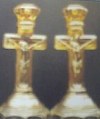Carnival Glass 101 | home Quick Reference to Carnival Glass Patterns on This Site
Table Sets - Part 2
COMPLETE TABLE SETS - Part 2
The following statement concerning Doped Ware was written years ago by the late Frank M. Fenton.
THE “DOPED WARE” AGREEMENT
It is generally accepted that the Fenton Art Glass Company was the first company to offer patterned iridescent ware to the commercial trade in 1907. This glass was subsequently (about 1950) named “Carnival Glass” by collectors and researchers. The glassworkers in the factories making this unusual glass called it Doped Ware.
The name comes from the material that was sprayed on this glass while it was very hot. The men called it “Dope”. It was mixed in a small separate building called the “Dope House”. The hotter the glass when it was sprayed, the better the color of the iridizing. The material was usually ferric chloride or stannous chloride or a combination of the two, dissolved in a liquid solution.
Many people would like to know, “If Fenton started in 1907, when did the other companies start to make Carnival Glass?” The Butler catalog in the Fall of 1908 shows 23 separate pieces of Marigold Carnival by Fenton and a sugar and cream by Westmoreland.
Here are two reprints of Fenton Carnival items from that catalog. Figure 1 shows the “Waterlily and Cattail” pattern in Marigold.
Figure 2 shows six small “Waterlily and Cattail” shapes made from the spooner and small berry dish shown in Figure 1, plus three bowls and a vase in “Diamond Point Columns” (Hartung Book 1), two small nappies in “Beaded Stars”, a “Smooth Rays” comport and two other small pieces, all in Marigold.
By January 1909, I am sure that both Imperial and Northwood were making Carnival based on the following agreement of March 22, 1909, between the workers of Local #9 (Northwood), Local #13 (Imperial), and Local #22 (Fenton). These were local unions of the American Flint Glass Workers Union, founded in 1878. (Agreement written on Northwood letterhead).
The agreement was controversial because the managements of Imperial and Fenton were not involved in the agreement. It was the practice of the Union to attempt to get all companies to conform to any agreement made by one of the companies with its workers. The glass companies were joined together in the National Assoc. of Manufacturers of Pressed and Blown Glassware. This association bargained with the AFGWU for the whole industry and negotiated and settled disputes at an annual joint conference held in Atlantic City, New Jersey.
“Unlimited Piece Work” was a system of paying the glassworker only for the good pieces produced with no guarantee of payment for his hours worked. If he produced no good pieces, he got no pay.
In a conversation with Frank: The question was: “What is the method for producing “powder blue”? Frank's reply: “Too much stabilizer in the mix produced powder blue. It was never intended as a color range to be had; and the marigold overlay was what would normally have been put on the clear glass.”
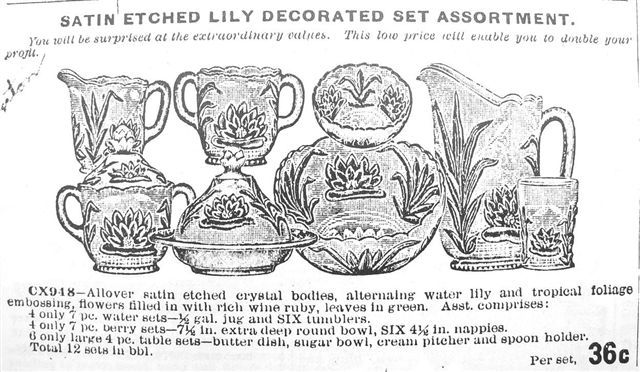
Figure 1, Fall 1908 Butler Bros. Catalog. Fenton written in by Frank M. Fenton.
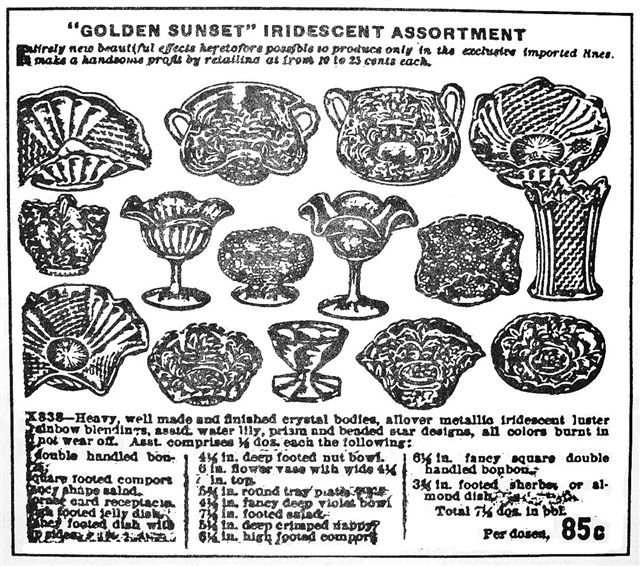
Figure 2, 5 shapes shown in Waterlily and Cattail pattern.
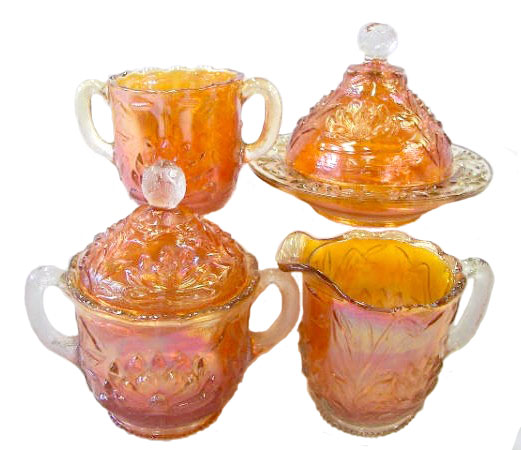
WATERLILY & CATTAIL Table Set found in marigold only.
WATERLILY and CATTAIL: is said to be the first carnival glass pattern produced by Fenton. Marigold was a mainstay from the beginning. This pattern had been a good seller in Chocolate Glass and opalescent ware, so it was a fair assumption that the new iridescent color would be accepted as well.
Many of the complete table sets displayed in this and future segments on the subject are from the vast collection of the late Chuck and Marge Kremer of Indiana. Chuck was forever “upgrading” his set pieces. His explanation of that procedure: “If you collect table sets, you can expect to collect some damage”! Since this Waterlily and Cattail set was produced very early-on in the iridized era, we are of the firm conviction that scarcity of the pieces is the result of “use” by its first owners. Determination is required to put a set together, with more than a year of search between each element, in some cases. The set sold in the 9-21-07 Wroda Auction performed during the 2007 www.cga Convention held in Indianapolis, IN sold for a mere $500, with some damage evident.
At this point in time, more than three years have transpired while we have accumulated three pieces to that set, continuing to look for the creamer. We have more than $500. invested in those three elements! This latest complete set was the FIRST offered for public sale in many years. A complete set sold privately for $3,000 in recent years.
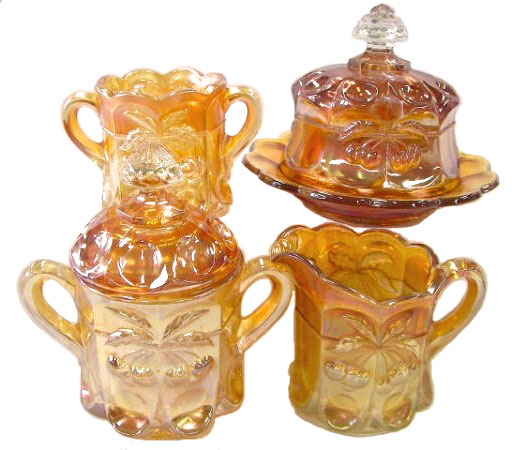 |
|
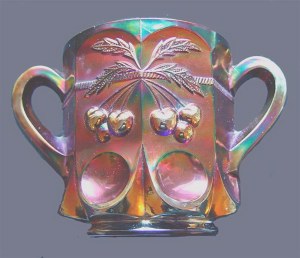 |
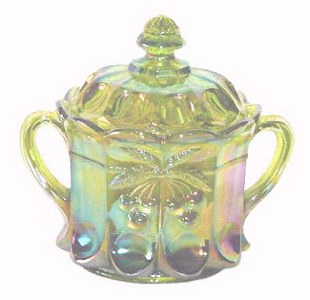 |
CHERRY & CABLE
Spooner in BLUE.
|
CHERRY & CABLECovered Cracker Jar in Ice Green.
|
The above spooner and cracker jar are reproductions by Mosser.
|
|
CHERRY & CABLE: was Northwood's first “full line” pattern to undergo carnival production in 1908. It had met success previously in color stained crystal. In that form, a berry set, table set, water set, a banquet size punch set having stemmed punch cups, a covered cracker jar and a handled celery vase were produced. Carnival shapes known are limited to a berry set, table set, and water set………all have been reported only in marigold.
Reproductions by Westmoreland and Mosser are rather extensive.
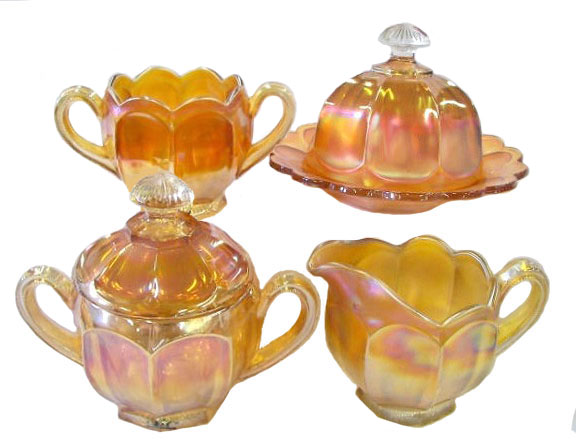
N. FLUTE - 1909 - Table set found in marigold and green.
This set, $550. 9-21-07.
FLUTE: The pattern had a lengthy production run in non-iridized crystal. It came into carnival production in early 1909. Berry set, table set, water set, breakfast size sugar and creamer, celery vase, stemmed sherbet, nut cup, and a pedestal footed salt set were all manufactured in marigold. A few of these shapes are found in purple and others in green, vaseline, blue and white.
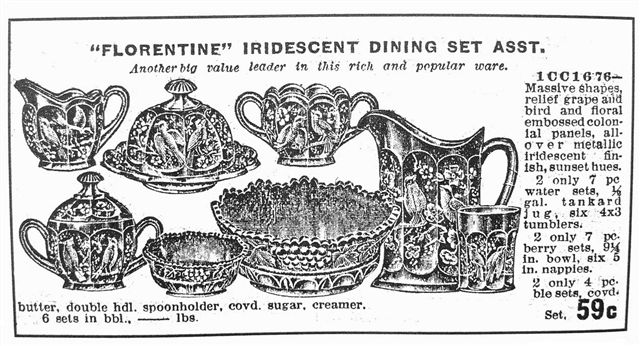
Feb. 1912 Butler Bros. Ad showing Singing Birds set
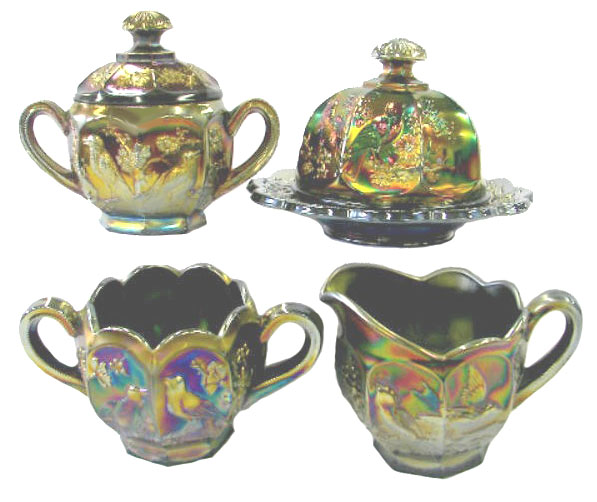
SINGING BIRDS - Green
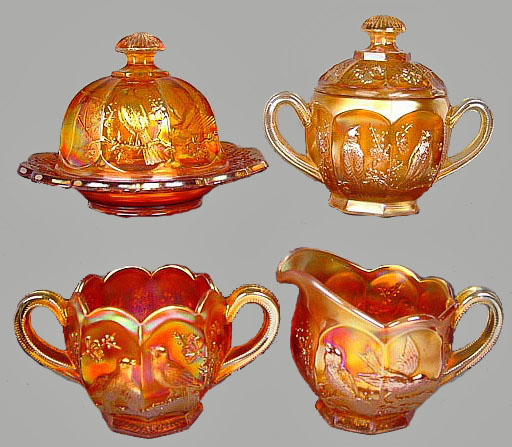
SINGING BIRDS Table Set in Marigold.
SINGING BIRDS : Table sets, berry sets and water sets are known in marigold, amethyst and green. Variations of color are found in the tumblers (olive green, horehound, and smoke). Known tumbler reproductions thought to have been made by Summit Art Glass Co.-aqua opal, ice blue opal and a bright, gaudy amethyst. These are unmarked.
Iridescent production of Singing Birds dates to circa 1911-Northwood.
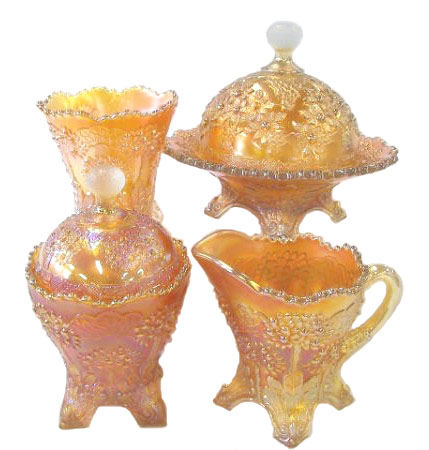
Orange Tree, Footed
ORANGE TREE - Footed: Marigold and Blue comprise the color spectrum of 4-piece table sets in this pattern, although a complete white butter dish and creamer are known in white. Another creamer is known, having gold trim. Fenton may have produced a short run of the white, after earlier sales of marigold and blue trailed off?
These footed areas nearly always have some damage when found in today's world.
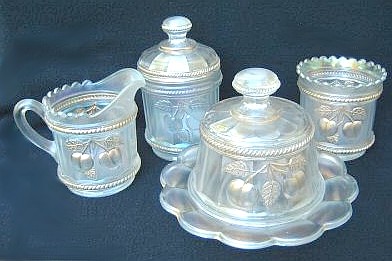
PEACH in White Iridized with gilt trim.
$1600. Wroda Auction - 9-21-07
PEACH: The full table set is known primarily in white, usually having the gold trim, which is fired on. Cobalt blue spooner and creamer have been confirmed. A spooner has been confirmed in marigold. Butter dish and covered sugar in those colors have yet to turn up. Pattern dates from 1911-1912 timeframe.
Dean & Diane Fry - 10/07
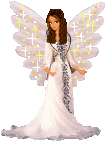 |
 |
 |
|
   |
How long, O Lord? Will You forget me forever?
How long will You hide Your face from me?
How long shall I take counsel in my soul,
having sorrow in my heart daily?
How long will my enemy be exalted over me?
Consider and hear me, O Lord my God;
enlighten my eyes, lest I sleep the sleep of death;
lest my enemy say, “I have prevailed against him”;
lest those who trouble me rejoice when I am moved.
But I have trusted in Your mercy;
my heart shall rejoice in Your salvation.
I will sing to the Lord,
because He has dealt bountifully with me.
~~ Psalm 13 ~~
Not ours to know the reason why
Unanswered is our prayer,
But ours to wait for God's own time---
To lift the cross we bear.~~Anon.
When we pray, God wraps us in His loving arms.
|
   |
|
 |
 |
 |
|
Should you care to contact the Frys, their email address is:
Search Carnival Glass 101
back to Carnival Glass 101
Our other sites you may enjoy:
Everything you EVER wanted to know about Indiana Glass
Great Reference for Newer Carnival Glass.
Complete Glassware Catalogs Available to Download
Questions? Comments? Suggestions? Broken Links? Corrections?
Your Friendly Webmaster is here to help!
